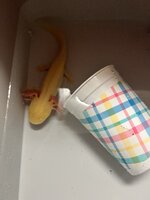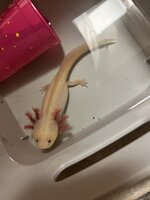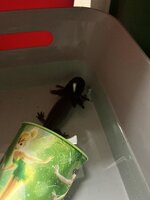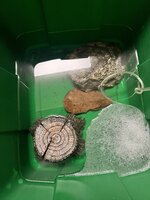GlossyGeek
New member
Hello
I am looking for advise from experienced axolotl breeders. I rescued three axolotl‘s January 3rd from a sketchy situation. The person was initially wanting to breed them, and purchased breeder axolotls. She then believed they were all females and too much work so she was ready to go ahead and get rid of them.
When I picked them up, they were extremely thin and I was mostly worried about just getting them to bulk up some. Even though she purchased breeder axolotls, she said she didn’t know how old they were which definitely doesn’t sound right because a breeder would want that information!!
I believe she didn’t want to tell me based on how scrawny they were - she seemed a little embarrassed. She told me and stressed the point that they each ate a full earthworm everyday. Unfortunately, I found that when I fed them earthworms they wouldn’t eat for two days afterwards. This was worrisome because the largest was 6 inches and none of their bellies were close to being the same size as their heads. After five days of this, I swapped them over to a high quality, nutrient dense, soft pellet that they cannot get enough of. As their main tank has been cycling, they have all been tubbed together, and I do daily 100% water changes.
I guess the bulking worked, as they are all considerably longer, and chunkier, and when I came home from the movies today, there were hundreds of eggs in their tub!!!!
At this point, I was shocked. I assumed based on what the previous owner told me and their original size, that they were not sexually mature or wouldn’t be for another few months. I was thinking I still had between 6 to 9 months still to go on my timeline.
I eventually did want to breed them, but I assumed I’d be purchasing a male and absolutely wasn’t ready for a clutch this soon. I don’t even know how old they are; based on their size when I picked them up, I assumed 6 months max!
Continuing to dig the hole with my assumptions… we thought “Smaug” (Melanoid Axanthic) could have been male, Tiamat (Golden Albino) was female, and Eeny (Leucistic) was female. (Best guess on the morphs)
Little did we know, Tiamat is actually Timmy and the other two are females based on the not enlarged cloaca. I suppose I should have been looking closer but since they’re tubbed, we are always looking from above them and missed it!
I’m not sure who laid the eggs. Smaug had always been the largest and chunkiest, today Smaug is looking quite a bit thinner. Eeny was the tiniest of the three when I got them, she had pretty much caught up to Smaug but is today noticeably larger than Smaug. (Belly)
Tiamat was the one we would make sure to feed more or worry about because the other two passed them up in size but now I’m thinking, it may be a result of them both being female. I though whoever was laying eggs wouldn’t want to eat but they all ate heartily yesterday as well as today after we moved them into temporary cells. (They are currently in temporary and separate small tubs until I can figure out the best way forward.)
My main problem is, I have a very little bit of time to set up a successful system that will also be ready in time to give theses babies their best chance at survival. From what I can guesstimate there are about 300 eggs - I haven’t flipped their hides to see what surprises might be waiting beneath.
Any advice from experienced breeders who have done this before would be appreciated but here are some of my main questions.
-How do I know which “female” laid eggs and is a vet necessary to find this out?
-There is no way they are 18 months, does anyone with experience know what harm can come to my female due to this or any actions that I can take to help?
-What are good practices or best ways to avoid cannibalism?
-Any recommended brands of brine shrimp and and maybe a multi-day hatching system until their front legs grow?
-I’m thinking live blackworms to get them through the cannibalistic/opportunistic period. Can anyone confirm this being a good idea or provide an alternative?
-Can anyone recommend how to go about sourcing blackworms from someone reputable and how to quickly propagating a colony to feed to the larvae? (Wanting to avoid disease from commercial markets)
-Can anyone recommend an inexpensive or diy rack system or grow out system?
-How soon do you start separating the morphs so that they don’t go for the less aggressive ones? (Wild types)
-Do I start to separate at the inch or half inch mark? (Specifically after they’ve grown arms and are in that snapping phase)
-Are automatic water change systems advantageous or am I better off with a turkey baster?
-Are there any experienced breeders in Denver wanting to take on a cluster of this clutch? Maybe to do a supply/equipment/expert-knowledge trade possibly?
Sorry for the long post but thanks in advance for the help and suggestions!!!!
(******Also, I did read the sticky posts, outside links, and informational posts - I just have some questions that I would like answered from a different point of view. I understand protecting the breed and culling genetic mutations that are harmful to the species. However, I don’t intend to cull so that I can “focus” better or make my life “easier.” I know it’s not going to be easy this first go round. Thanks!!)
I am looking for advise from experienced axolotl breeders. I rescued three axolotl‘s January 3rd from a sketchy situation. The person was initially wanting to breed them, and purchased breeder axolotls. She then believed they were all females and too much work so she was ready to go ahead and get rid of them.
When I picked them up, they were extremely thin and I was mostly worried about just getting them to bulk up some. Even though she purchased breeder axolotls, she said she didn’t know how old they were which definitely doesn’t sound right because a breeder would want that information!!
I believe she didn’t want to tell me based on how scrawny they were - she seemed a little embarrassed. She told me and stressed the point that they each ate a full earthworm everyday. Unfortunately, I found that when I fed them earthworms they wouldn’t eat for two days afterwards. This was worrisome because the largest was 6 inches and none of their bellies were close to being the same size as their heads. After five days of this, I swapped them over to a high quality, nutrient dense, soft pellet that they cannot get enough of. As their main tank has been cycling, they have all been tubbed together, and I do daily 100% water changes.
I guess the bulking worked, as they are all considerably longer, and chunkier, and when I came home from the movies today, there were hundreds of eggs in their tub!!!!
At this point, I was shocked. I assumed based on what the previous owner told me and their original size, that they were not sexually mature or wouldn’t be for another few months. I was thinking I still had between 6 to 9 months still to go on my timeline.
I eventually did want to breed them, but I assumed I’d be purchasing a male and absolutely wasn’t ready for a clutch this soon. I don’t even know how old they are; based on their size when I picked them up, I assumed 6 months max!
Continuing to dig the hole with my assumptions… we thought “Smaug” (Melanoid Axanthic) could have been male, Tiamat (Golden Albino) was female, and Eeny (Leucistic) was female. (Best guess on the morphs)
Little did we know, Tiamat is actually Timmy and the other two are females based on the not enlarged cloaca. I suppose I should have been looking closer but since they’re tubbed, we are always looking from above them and missed it!
I’m not sure who laid the eggs. Smaug had always been the largest and chunkiest, today Smaug is looking quite a bit thinner. Eeny was the tiniest of the three when I got them, she had pretty much caught up to Smaug but is today noticeably larger than Smaug. (Belly)
Tiamat was the one we would make sure to feed more or worry about because the other two passed them up in size but now I’m thinking, it may be a result of them both being female. I though whoever was laying eggs wouldn’t want to eat but they all ate heartily yesterday as well as today after we moved them into temporary cells. (They are currently in temporary and separate small tubs until I can figure out the best way forward.)
My main problem is, I have a very little bit of time to set up a successful system that will also be ready in time to give theses babies their best chance at survival. From what I can guesstimate there are about 300 eggs - I haven’t flipped their hides to see what surprises might be waiting beneath.
Any advice from experienced breeders who have done this before would be appreciated but here are some of my main questions.
-How do I know which “female” laid eggs and is a vet necessary to find this out?
-There is no way they are 18 months, does anyone with experience know what harm can come to my female due to this or any actions that I can take to help?
-What are good practices or best ways to avoid cannibalism?
-Any recommended brands of brine shrimp and and maybe a multi-day hatching system until their front legs grow?
-I’m thinking live blackworms to get them through the cannibalistic/opportunistic period. Can anyone confirm this being a good idea or provide an alternative?
-Can anyone recommend how to go about sourcing blackworms from someone reputable and how to quickly propagating a colony to feed to the larvae? (Wanting to avoid disease from commercial markets)
-Can anyone recommend an inexpensive or diy rack system or grow out system?
-How soon do you start separating the morphs so that they don’t go for the less aggressive ones? (Wild types)
-Do I start to separate at the inch or half inch mark? (Specifically after they’ve grown arms and are in that snapping phase)
-Are automatic water change systems advantageous or am I better off with a turkey baster?
-Are there any experienced breeders in Denver wanting to take on a cluster of this clutch? Maybe to do a supply/equipment/expert-knowledge trade possibly?
Sorry for the long post but thanks in advance for the help and suggestions!!!!
(******Also, I did read the sticky posts, outside links, and informational posts - I just have some questions that I would like answered from a different point of view. I understand protecting the breed and culling genetic mutations that are harmful to the species. However, I don’t intend to cull so that I can “focus” better or make my life “easier.” I know it’s not going to be easy this first go round. Thanks!!)




